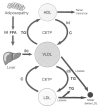Type II diabetes mellitus and cardiovascular risk factors: Current therapeutic approaches
- PMID: 18650975
- PMCID: PMC2359621
Type II diabetes mellitus and cardiovascular risk factors: Current therapeutic approaches
Abstract
Worldwide, approximately 200 million people currently have type II diabetes mellitus (DM), a prevalence that has been predicted to increase to 366 million by 2030. Rates of cardiovascular disease (CVD) mortality and morbidity are particularly high in this population, representing a significant cost for health care systems. Type II DM patients generally carry a number of risk factors for CVD, including hyperglycemia, abnormal lipid profiles, alterations in inflammatory mediators and coagulation/thrombolytic parameters, as well as other 'nontraditional' risk factors, many of which may be closely associated with insulin resistance. Therefore, successful management of CVD associated with diabetes represents a major challenge to the clinicians. An effective way of tackling this problem is to detect the associated risk factors and to target treatment toward their improvement. Targeting hyperglycemia alone does not reduce the excess risk in diabetes, highlighting the need for aggressive treatment of other risk factors. Although the current use of statin therapy is effective at reducing low-density lipoprotein cholesterol, residual risk remains for other independent lipid and nonlipid factors. The peroxisome proliferator-activated receptor-gamma appears to be closely involved in regulating risk markers at multiple levels. A relatively new class of therapeutic agents that activate peroxisome proliferator-activated receptor-gamma, the thiazolidinedione insulin-sensitizing agents, is currently used to manage type II DM. These agents display a number of potential antiatherogenic properties, including effects on high-density lipoprotein cholesterol and triglycerides, as well as other beneficial nonlipid effects, such as regulating levels of mediators involved in inflammation and endothelial dysfunction. Research data suggest that simple strategies combining thiazolidinediones and statins could have complementary effects on CVD risk-factor profiles in diabetes, alongside the ability to control glycemia.
Keywords: Coronary artery disease; PPAR-γ; Therapy; Type II diabetes.
Figures


References
-
- Underwood JCE. General and Systematic Pathology. Edinburgh: Churchill Livingstone; 1992.
-
- Morrish NJ, Wang SL, Stevens LK, Fuller JH, Keen H. Mortality and causes of death in the WHO Multinational Study of Vascular Disease in Diabetes. Diabetologia. 2001;44(Suppl 2):S14–21. - PubMed
-
- Williams G, Pickup JC. Handbook of Diabetes. Oxford: Blackwell Science Inc; 1998.
-
- Geiss LS, Herman WH, Smith PJ. Diabetes. 2. National Diabetes Data Group, National Institutes of Health, National Institute of Diabetes and Digestive and Kidney Diseases; 1995. Mortality in non-insulin-dependent diabetes; pp. 233–257. NIH Publication No. 95–1468.
-
- Caro JJ, Ward AJ, O’Brien JA. Lifetime costs of complications resulting from type 2 diabetes in the U.S. Diabetes Care. 2002;25:476–81. - PubMed
LinkOut - more resources
Full Text Sources
Other Literature Sources
